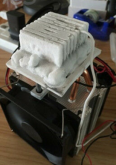svConcordia
New Member
- Joined
- Jan 16, 2020
- Messages
- 11
Folks ... While my thread may be betters suited for the beginner's corner, fellow boaters may better understand my challenge.
We have been commuter cruising our 43 foot Cape North Cutter Concordia in the Sea of Cortez for three years now. The first two years we were able to visit the boat twice, with one trip earmarked as "maintenance," which meant the wet cell (4 6v 240ah golf cart batteries) took about 1.5 gallons of distilled water each visit (about 6 month interval). Work and an emergency room visit precluded all trips to Guaymas in 2019 and assuming our March plans go forward, Concordia will have been on the hard with no visitors for 16 months. So, yeah, pretty sure the house bank is done. As our commuter cruising habits are likely to continue for another four to five years - and we don't want to continue wasting wet cell batteries - we are looking to replace with LifePo4 batteries, but need the community's guidance. Details about the ship's currents system:
Thanks
We have been commuter cruising our 43 foot Cape North Cutter Concordia in the Sea of Cortez for three years now. The first two years we were able to visit the boat twice, with one trip earmarked as "maintenance," which meant the wet cell (4 6v 240ah golf cart batteries) took about 1.5 gallons of distilled water each visit (about 6 month interval). Work and an emergency room visit precluded all trips to Guaymas in 2019 and assuming our March plans go forward, Concordia will have been on the hard with no visitors for 16 months. So, yeah, pretty sure the house bank is done. As our commuter cruising habits are likely to continue for another four to five years - and we don't want to continue wasting wet cell batteries - we are looking to replace with LifePo4 batteries, but need the community's guidance. Details about the ship's currents system:
- Charging System
- Three 100 watt Renogy Monocrystalline Photovoltaic PV Solar Panels
- Victron MPPT 100/30 with VE. Direct Bluetooth Dongle
- 50 amp engine mounted alternator (no smart charging, stock alternator for Bukh DV-36)
- 30 amp smart charger (when shore power is available)
- Major Demands
- Raymarine autopilot
- Radar
- Frigoboat 12v Refrigeration
- Inverter (usually runs a hand mixer, shop vac, electric drill)
- Battery Management System n' stuff: I'm a bit bewildered on which BMS to pair with this system and whether there are any conflicts/opportunities with the Victron MPPT. In another thread, there seemed to be a discussion over BMS that networks with the Victron.
- Does the BMS matter in relation to the MPPT?
- Is there an advantage with a BMS that networks with the MPPT?
- Anything else that needs to go into battery box or connected to the system? 12v relay terminal?
- Storage: Baja is an extreme environment and Concorida will go for months without a visitor and temps can run well into the 100s.
- While there is a minor current draw while away (I leave a radio and some 12v fans running), what happens when it is left alone for a year and no major load?
- If there interior of the boat is 100+ degrees, is there any safety or system risks? Should I build a battery box that incorporates a 12v fan?
- Is there a BMS that can be programmed to place a periodic load on bank (and is this important)?
- Or should I plan on hauling the house bank home ... even though it will be a 16 hour drive?
Thanks



